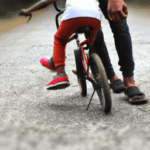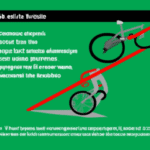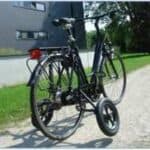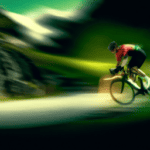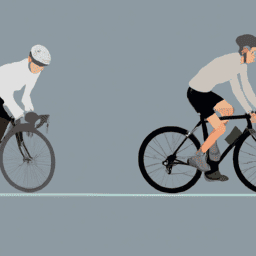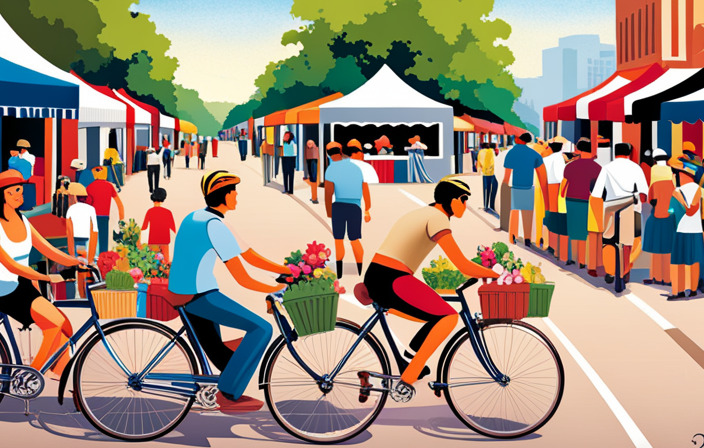Having taught a significant number of adults to cycle, I am well-acquainted with the apprehensions and obstacles they face when picking up this skill. Yet, I’ve also witnessed the immense satisfaction and exhilaration they experience once they overcome these hurdles and revel in the liberty and happiness cycling brings.
In this article, I will share my tips and strategies for teaching an adult to ride a bicycle, from preparing for the lesson to progressing to more advanced skills.
First and foremost, it’s important to remember that everyone learns at their own pace and in their own way. As a teacher, it’s essential to be patient, encouraging, and supportive throughout the learning process.
With the right preparation, building confidence and balance, and overcoming fear and anxiety, anyone can learn to ride a bicycle, regardless of age or previous experience.
So let’s get started on this exciting journey towards cycling proficiency!
Key Takeaways
- Choose a safe and spacious location and select the right equipment
- Start with balance drills and gradually progress to more advanced skills
- Practice turning and maneuvering, and work on building endurance and speed
- Patience and support from the teacher are essential, and setbacks are normal and part of the learning process.
Preparing for the Lesson
Get ready to feel the excitement and anticipation of finally learning to ride a bike by preparing for the lesson ahead of time.
The first step in preparing for the lesson is to choose a location that is safe and spacious. Look for a smooth, flat surface that is free of obstacles such as rocks, curbs, and potholes. A park or an empty parking lot is an ideal location to start with.
After choosing the location, the next step is to select the right equipment. Make sure that the bike you’re using is the correct size and in good condition. The seat should be adjusted so that you can reach the ground with both feet while seated.
It’s also important to wear a helmet that fits properly to protect your head in case of any falls. With the right location and equipment, you’ll be ready to start building your confidence and balance on a bike.
Building Confidence and Balance
By practicing gentle turns and quick stops, you’ll soon be gliding with ease and feeling more confident on two wheels. It’s important to start with balance drills, such as standing with one foot on a pedal and the other on the ground, or using training wheels to get used to the feeling of being on a bike.
Gradual progress is key, so don’t rush into riding without first building up your confidence and balance. Another helpful exercise is practicing riding in a straight line while looking ahead, rather than down at your feet or the bike. Once you feel comfortable with this, try turning slightly while maintaining your balance.
Remember to be patient with yourself and your progress, and use positive reinforcement to boost your confidence. With time and practice, you’ll soon be ready to move on to more advanced techniques for riding a bicycle.
Developing confidence and balance is an important step in learning to ride a bicycle as an adult. However, it’s normal to experience some fear and anxiety during this process.
In the next section, we’ll discuss how to overcome these feelings and continue making progress towards your goal.
Overcoming Fear and Anxiety
Although it’s completely normal to feel scared or anxious, it’s important to remember that conquering these emotions is crucial for achieving your goal of becoming a confident cyclist. Managing your expectations is key.
Don’t expect to be able to ride like a pro on your first try. It’s okay to start small and work your way up to more advanced skills. Dealing with setbacks also comes with the territory.
Don’t get discouraged if you fall off the bike a few times or struggle with balance. Just remember that every cyclist has gone through the same process of learning and improving.
The best way to overcome fear and anxiety is to take things one step at a time. Start by practicing in a safe and quiet area, such as an empty parking lot or a park with a paved trail. Take breaks as needed and don’t push yourself too hard.
As you become more comfortable with the basics, gradually progress to more advanced skills, such as riding up hills or navigating through traffic. With time and practice, you’ll be able to ride confidently and enjoy all the benefits that cycling has to offer.
Progressing to More Advanced Skills
Now that I’ve become more comfortable on the bicycle, it’s time to progress to more advanced skills.
Learning to start and stop smoothly is a key skill that will make me feel more confident on the road.
Practicing turning and maneuvering will also help me navigate through traffic and avoid obstacles.
Finally, building endurance and speed will allow me to enjoy longer rides and explore new areas.
With practice and patience, I know I can master these skills and become a skilled cyclist.
Learning to Start and Stop Smoothly
When you’re learning to ride a bike, it’s important to focus on starting and stopping smoothly so that you can feel confident and in control. To start, position yourself on the bike with one foot on the ground and the other foot on the pedal. Push off with the foot on the ground to gain momentum while simultaneously pushing down on the pedal with your other foot.
As you gain speed, lift your other foot onto the pedal and keep pedaling to maintain your balance. It’s important to keep your upper body relaxed and centered over the bike, and to avoid leaning too far forward or backward.
Stopping smoothly is just as important as starting smoothly. To stop, gradually slow down by pedaling backward or using the brakes. As you come to a stop, put one foot on the ground and keep the other foot on the pedal at the top of its rotation. This will help you maintain balance and prevent the bike from tipping over.
Remember to keep your weight centered over the bike, and avoid leaning too far forward or backward. With practice, starting and stopping smoothly will become second nature, and you’ll be ready to move on to practicing turning and maneuvering.
Now that you have a good grasp on starting and stopping, it’s time to focus on practicing turning and maneuvering.
Practicing Turning and Maneuvering
As I become more comfortable on the bike, it’s time to focus on honing my turning and maneuvering skills through deliberate practice. Here are some tips to help me improve:
-
Look where I want to go: This is a crucial tip for turning and maneuvering. I need to look in the direction I want to go and my bike will follow. This means keeping my head up and looking ahead, rather than down at the ground.
-
Practice braking techniques: Being able to stop quickly and smoothly is essential for safe turning and maneuvering. I can practice braking by riding at a moderate speed and gently squeezing the brakes to slow down. As I become more comfortable, I can increase my speed and practice stopping more quickly.
-
Ride on different terrains: Riding on different surfaces such as pavement, gravel, or grass will help me develop my maneuvering skills. Different surfaces require different techniques, so it’s important to practice on a variety of terrains.
-
Use my body weight: Leaning my body in the direction of the turn will help me steer the bike. This means leaning to the right when turning right and leaning to the left when turning left.
As I continue to improve my turning and maneuvering skills, I can start to focus on building endurance and speed.
Building Endurance and Speed
To build your endurance and speed on the bike, it’s important to focus on endurance training and speed intervals.
Endurance training involves gradually increasing your distance and pace over time. You can do this by gradually increasing the distance of your rides each week and gradually increasing the pace of your rides as your body becomes stronger.
Speed intervals, on the other hand, involve alternating between periods of high intensity and low intensity riding. You can do this by riding at a high intensity for a certain amount of time, followed by a period of low intensity riding or rest. This type of training helps to improve your overall cardiovascular fitness and can help you to build speed and endurance on the bike.
By incorporating these training methods into your cycling routine, you can gradually build your endurance and speed on the bike, allowing you to enjoy longer rides and more challenging terrain.
As you become more comfortable and confident on the bike, you can start to enjoy the benefits of cycling, such as improved physical fitness, stress relief, and the opportunity to explore new places.
So, let’s move forward and discuss ways to maximize the joys of cycling.
Enjoying the Benefits of Cycling
Cycling is like flying, giving me a sense of freedom and enjoyment that can’t be matched by any other mode of transportation.
It’s no wonder why cycling has become one of the most popular activities worldwide. Not only is it a great way to relax and clear your mind, but it also offers numerous health benefits.
By teaching an adult how to ride a bicycle, you’re opening up a world of possibilities for them.
One of the key benefits of cycling is that it promotes a healthy lifestyle. It’s a low-impact form of exercise that can improve cardiovascular health, build muscle, and increase endurance.
Additionally, cycling can be a great way to explore the outdoors. By introducing an adult to safe cycling routes, they can experience the beauty of nature while getting some exercise at the same time.
Overall, cycling is a fun and healthy activity that everyone can enjoy.
Frequently Asked Questions
What type of bicycle is best for an adult beginner?
As an adult beginner, it’s important to choose the right size bicycle. Mountain bikes are versatile and great for off-road terrain while road bikes are lighter and faster on pavement. Consider your goals and terrain before making a choice.
How long does it typically take for an adult to learn how to ride a bicycle?
Learning to ride a bicycle as an adult can take anywhere from a few hours to a few weeks, depending on the individual. Common challenges include balance and fear of falling, but staying motivated with small victories and positive reinforcement can help overcome these obstacles.
What should I do if I have trouble with a specific skill, such as turning or braking?
Oh joy, another adult struggling with basic bicycle skills. Fear not, dear reader, for I have the solution to all your troubles. Common mistakes can be fixed with simple troubleshooting techniques. Building confidence and breaking down mental barriers is key.
Can I still learn how to ride a bicycle if I have physical limitations or disabilities?
Yes, it’s possible to learn how to ride a bike with physical limitations or disabilities. Adaptive equipment and training techniques can help. It may take more time and patience, but don’t give up.
How can I find a suitable instructor to help me learn how to ride a bicycle?
As someone who wants to learn how to ride a bicycle, I understand the importance of finding a qualified instructor who can teach me at my own pace. It’s important to do research and ask for recommendations to ensure a successful learning experience.
Conclusion
In conclusion, teaching an adult to ride a bike can be a challenging but rewarding experience. By following the steps outlined in this article, you can help your student build confidence, overcome fear and anxiety, and progress to more advanced skills.
Remember to be patient and encouraging throughout the process, and to always prioritize safety. As a cycling enthusiast, I know firsthand the many benefits of this activity – from improved physical health to reduced stress and increased happiness.
So, if you have an adult in your life who’s eager to learn how to ride, don’t hesitate to take on the challenge. With a little patience, determination, and a lot of practice, you’ll be riding together in no time.


